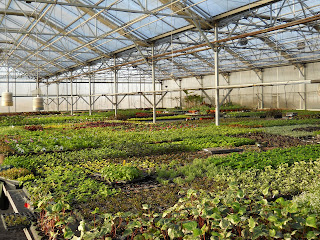Hunter yawns as Carlos mows
I am sure Hunter would yawn here while Jr. is mowing
We mowed greens for the first time on Wednesday and Thursday of this week and we're trying something a little different this year. There is a great deal of research to suggest that putting green quality can be maximized through a rolling and mowing program. The grounds department is entering this year expecting to mow greens 4 days a week and roll greens the other 3 days. The idea being that saving the grass the inherent injury from mechanical clipping removal (mowing) as much as possible and rolling will increase plant health, save us some time, some gas and ultimately a little money. We'll see so I'll keep you posted.
A specialized brush for putting green maintenance
At the end of 2010 we were able to purchase the above brush from a local golf course that was going to trade it in. This is a brush called a 'Sweep n fill' that is designed to incorporate sand topdressing into the grass on our greens. We use it to 'groom' the greens as well. The brushing action will stand the grass up to improve the quality of cut the greens. We anticipate using this machine once a week, again, to improve the overall quality of our putting surfaces. Bryan Stephen, our equipment technician, figured out to weld a trailer hitch to the triplex for improved maneuverability, and less wear and tear than using standard golf carts or utility vehicles. Thanks, Bry!
Putting green near the Shiraz parking lot
Some of the damage on the green
BIG is one thing we do well at Indian Lakes Resort and we have space for a 'nursery' green by our restaurant, Shiraz on the Water. This 7000 square foot green was partially stripped in 2008 during construction of the Island golf course to sod some areas on greens as they were grown in. In the spring of 2009 we re-established the green by spreading aerification cores across the entire green. The cores will survive and grow and are a cheap method of putting green restoration. This method also enjoys the added benefit of being genetically identical to the putting surfaces on the golf course. Some of the damage you see in the bottom photo is where sod that was stripped in 2008 never fully recovered in subsequent years. We will be addressing these areas with sand and seed in the coming weeks to ensure full recovery and, hopefully, excellent putting quality.
#1 Woodland Ladies tee box
The above photo illustrates the benefit of late-fall or dormant fertilization in the fall months. This tee box received a fall fertilization application from some fertilizer I was able to get from a local golf course that had unwanted inventory. We treated a few of our problem tees last fall.
#1 Highland Professional tee box
This photo of an untreated tee box shows the difference in spring green up on untreated versus treated turf. The benefits of late-fall fertilization include improved spring green up, increased rooting in the spring months and better turf quality throughout the growing season. For those of you at home who want to provide minimal fertility to your home lawn it's important to remember that fall is the best time to apply fertilizers.
John Pascente changing the oil in something, somewhere
Well, that's all for now. Our seasonal staff begins on Monday, April 4th. Here's hoping for a great year!

















